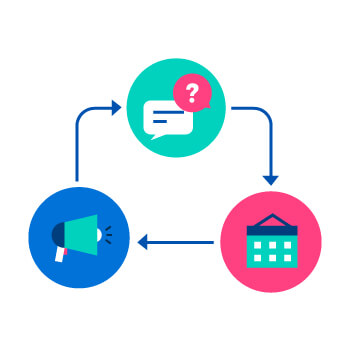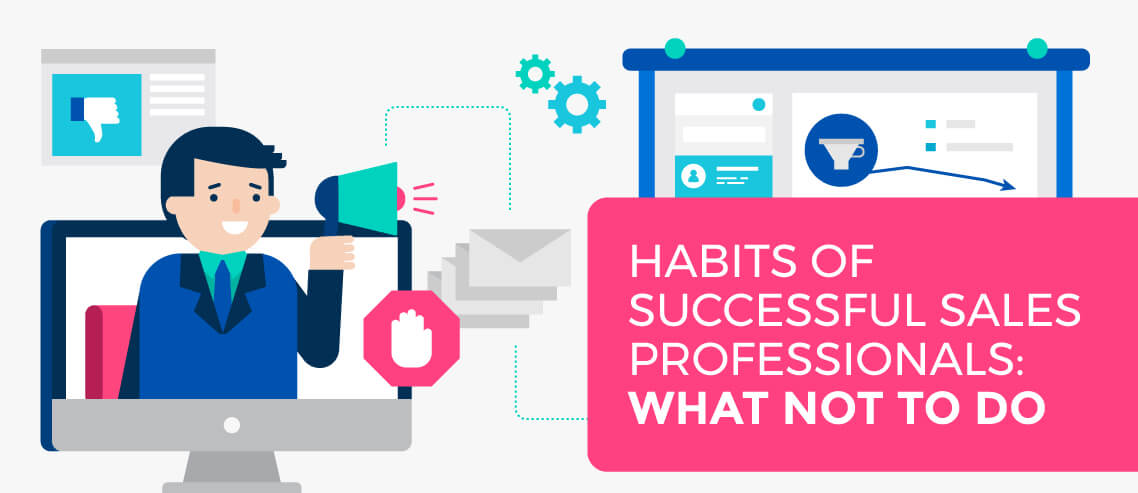How to Get More Sales Referrals (Hint: You Have to Ask for Them)

Contents
There are many ways to pursue sales referrals and generate new business, but one of the most effective is also one of the most underutilized: asking your current customers.
Referrals are one of the best tools for generating quality leads. For example, referral marketing platform Referral Candy has seen success rates climb as high as 7.5%. That means more than 7 in 100 sales resulted from a referral.
Adjust how you allocate your time spent on sales and marketing, and you might see even greater numbers of sales being driven by referrals.
So why are referrals such an effective sales tactic?
For one, it puts the onus on your current customers to do the hard work for you. You also benefit from “social proof.” Leads generated via referrals are more likely to convert, simply because they trust the source of the introduction.
What’s more, referred customers typically stick around longer and spend more than customers acquired by other means. One study found that “referred customers spend 10-25% more on their initial purchase and make significantly more repeat purchases.” The average lifetime of a referred customer is also around 16% longer than customers acquired from other channels.
But despite all this, referral marketing is still a woefully underused sales tactic.
Why Companies Aren’t Asking for Referrals
There are numerous reasons companies fail to ask for referrals. Just for starters:
- They think referrals are less effective than other sales channels
- They plan to but haven’t gotten around to implementing a system to ask for them
- It just hasn’t occurred to them to ask
Or, as sales guru Joanne Black states in the podcast “Stop Cold Calling and Get Referrals Instead“:
- They’re scared of rejection
- They don’t want to cheapen their relationships by commoditizing them
- They think referrals should happen naturally
None of these, however, are reasons to avoid asking for referrals.
We already know referred customers stick around longer and spend more than customers acquired by other means. We also know that while rejection sucks, when you do get a “yes,” the odds that lead will convert are pretty damn high.
Basically, there’s no good reason not to be asking for sales referrals.
So what’s the next step? How can you start asking for sales referrals and maximize how many of those referrals you convert into new business?
Develop a Sales Referral Process
If you want your organization to invest in referrals, you need to develop a defined process. Asking for, following up on, and converting referrals should become an innate element of your sales process.
However, as Black suggests, don’t assume that salespeople will naturally think to ask for referrals. It’s a different skill set, and not one that people are naturally comfortable with – even your most skilled and experienced salespeople.
Asking for referrals should be something that’s happening every single day. In order to make that happen, you need to devise a strategy and a process, track the right metrics, and train your salespeople on the right way to ask for referrals.
1. Devise a strategy
Asking for referrals requires a little finesse and a consistent plan that’s repeatable. Here are a few questions to help you get started:
- Will your approach be direct, such as phone calls and personalized emails? Or more passive like automated emails? Which option is scalable for your business?
- Will you request referrals from all customers or only certain segments like key accounts?
- How will you track the success (or failure) of the referral process? When will you reevaluate your approach?
- How will you show your customers you really care?
2. Create a process
Once you have your strategy, it’s time to figure out the best way to execute it. What should occur to ensure successful referrals aren’t forgotten, conversion rates are as high as possible, and introductions actually take place?
- Ask before the project is over: It’s a common misconception that the best time to ask is when the project is over. Try threading in continuous feedback and consider asking at your first major milestone that leaves them feeling satisfied.
- Find a way to make it personal: A generic email at the end of your project won’t cut it. If possible, ask in-person or over the phone to give a personal touch. Offering such a direct approach is hard to ignore and forces them to stop and really consider any possible referrals they could send.
- Make it easy: Referring you shouldn’t come with a bunch of hoops to jump through. Give them a template email with some clear benefits to choosing you that they can send as is or personalize if they wish.
- Offer an alternative: If they’d prefer not to offer a referral or can’t think of anyone right now, ask what else they’d be willing to do. Perhaps they could give you a testimonial for your website or social media? Or they’d be willing to make a post on your behalf? Get creative here and make the process feel natural and comfortable.
- Reciprocate when possible: Are there any situations where you can offer them a referral? If so, ask them what the best way to refer them would be. Often, they’ll also reciprocate and ask you in return.
- Circle back with them: Whether they sent a referral initially or not, it’s never a bad idea to set a reminder to follow up 2-3 months down the road to see if they have more referrals to offer.
3. Track the right metrics
You’ve made serious headway with your strategy and execution plan, and now it’s time to ensure you see results. Here are some must-track metrics to gauge the success of your referral campaigns:
- Recipient Clickthrough Rates: The number of referrals opening emails and clicking your links.
- Formula: # of links clicked divided by # of emails opened
- Referral Page Hits: The number of referrals reaching your referral pages.
- Formula: # of people visiting the referral landing pages
- Referral Rate: Number of referrals actually purchasing.
- Formula: # of referred purchases divided by # of total purchases
- Customer Acquisition Costs (CAC): How much it costs you to acquire a single customer. Sustainable growth is all about spending less money on acquisition than you receive in profits. Customer referrals are a low-cost or even free way to keep CAC low.
- Formula: All costs spent on acquiring customers (like marketing) divided by the total # of customers acquired during the period the acquisition costs were incurred
- Lifetime Value (LTV): Referred customers generally have lower CAC rates, higher retention rates, and as a result, higher LTV rates.
Formula: Take average purchase value and multiply by the average purchase frequency to find customer value. Then, take customer value and multiply that by the average customer lifespan to find LTV.
4. Implement a training program
To many salespeople, asking for and converting referrals is a brand-new skill. Learning that skill takes training and practice.
Implement a training program designed to teach your salespeople (or yourself) the right way to ask for referrals, and the right way to nurture and convert the ones they secure.
Setting up a referral request process that brings in real results takes time and patience. Even naturally adept sales reps require consistent training to hone their skills.
Multi-day training days can be effective in certain contexts, but too much time off the sales floor can be costly. Instead, focus on micro-learning opportunities in team meetings, core groups, or one-on-ones where they can review referral request best practices and try them out with a colleague or a manager.
Take advantage of call recording software and spend time studying past calls of successful referral requests to share success with the team.
How to Ask for Sales Referrals
Once you have your process in place, you need to actually make that all-important ask.
Pick the Right People
You don’t have to ask every customer for a referral. Start by asking your advocates, those who are not only happy to refer you, but will be able to “talk you up” appropriately.
If you’re not sure who your advocates are, you can find out using a Net Promoter Score survey. Using a scale of 1-10, simply ask your customers to rate their satisfaction with your product or service. Those who rate you a 9 or 10 can be placed in the “advocate” column, and should be approached for referrals first.
You can work your way down from there and ask for referrals from customers you know are happy but might not reach advocate status. Just don’t ask for a referral from those who rate you below a 5.
Time Your Ask Right
As with most things in life, there is a right and a wrong time to act. In this context, the right time to act depends on who you’re asking.
When it’s the right time to ask for a referral: Black states that the best time to ask for referrals is when you prove value to the client. If you don’t ask then, you risk never asking. You’ll convince yourself that it isn’t the right time over and over again until you’re too far out to ask.
When you’re talking about an advocate, it’s always the right time to ask. They already love you, so they won’t be offended or put off by it.
When it’s the wrong time to ask for a referral: When a customer has just recently come on board or they’ve recently complained. Give customers a chance to become acquainted with your product and realize its benefits before asking for that referral.
Ask in the Right Way
The right way to ask for a referral primarily depends on who you’re asking. The nature and size of your business are factors as well.
Asking advocates for referrals: In this instance, the ask should be super-personal. If you talk to them often, just bring it up in conversation the next time you speak.
You might say something along the lines of “Hey, I was wondering if you would do me/us a favor … Can you think of anyone who might be interested in our product? Are you able to introduce me?”
If you know a customer is an advocate but you never actually speak to them, send a highly-personalized email instead.
Asking happy customers for referrals: Not every customer who is happy is an advocate, but this doesn’t mean they won’t willingly refer you to someone else.
Again, if you talk to the customer often, just bring it up in conversation. If you don’t, email them.
If you have a large business with a lot of happy customers, you might need to scale this and work from templates, rather than writing a personalized message from scratch. You can streamline this process using a tool like Mailshake, which enables you to send templated yet personalized emails, in addition to tracking open and response rates.
In all instances, it helps to be specific. As Black states in the podcast, you don’t want just “anybody who might be interested.” Instead, ask “Who are one or two people you can introduce me to?”
Put the Building Blocks in Place for Nurturing Leads
Black’s podcast outlines the ideal scenario: It’s best to have the person you’re asking for the referral go out, talk about you to someone else, and then point them in your direction.
Unfortunately, things don’t always play out that way.
Just because a customer says they’ll talk to a friend about you doesn’t mean they will. Just because that customer is “really confident” their friend will be interested doesn’t mean they’ll call.
Even if the customer says they’ll handle the introduction, you should still ask for the person’s contact information. This will allow you to contact them directly if need be, and it will give you an opportunity to conduct some quick research on the referral as well.
Offer an Incentive
It’s no secret that incentives make people far more agreeable and much more likely to refer you.
If you’re worried this might “cheapen” the relationship between you and a customer by commoditizing it, avoid using the word “incentive” and pitch the reward as a “thank you” instead.
Follow Up
So you’ve reached out, either by asking a customer for a referral, or to someone a customer has referred to you. A few days have passed, and although things seemed so promising … you’re faced with a wall of silence.
Don’t take it personally. There are a multitude of reasons people don’t reply, particularly when it’s not a cold contact. This silence is more likely due to prioritization or forgetfulness than a lack of interest.
I recommend you follow up in pretty much every sales scenario, but when you’re pursuing the type of warm leads sales referrals produce, failing to follow up is the ultimate error.
Unless you’ve been explicitly told they’re not interested, always follow up.
Always Say Thanks
This is good advice in life, period. Always show gratitude when someone does something nice for you.
However, it’s even more important in business. If you fail to say “thanks” when someone sends you new business, you’re doing yourself and your company a massive disservice. Not only is that customer much less likely to make subsequent referrals, but their loyalty to you is likely to drop a little as well.
So, whether you’re incentivizing referrals or not, always thank referring customers for their help. This means both after your initial ask and if (or when) a referral successfully materializes.





